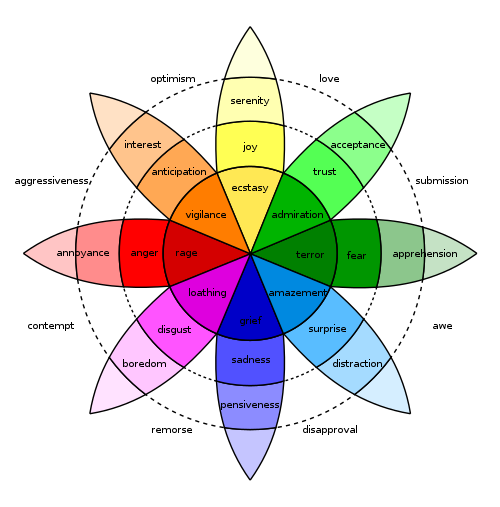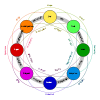Hatred
Hatred is a feeling. It can cause an angry, or resentful emotional response, which can be used against certain people, or ideas.[1]
Hatred is often associated with feelings of anger, disgust and a disposition towards the source of hostility.
As emotion
As an emotion, hatred can be short-lived or long-lasting.[2] It can be of low intensity - 'I hate broccoli' - or high intensity: 'I hate the whole world'.[3]
Robert Sternberg saw three main elements in hatred:
- a negation of intimacy, by creating distance when closeness had become threatening;
- an infusion of passion, such as fear or anger;
- a decision to devalue a previously valued object.[4]
The important self-protective function, to be found in hatred,[5] can be illustrated by Steinberg's analysis of 'mutinous' hatred, whereby a dependent relationship is repudiated in a quest for autonomy.[6]
Psychoanalytic views
Sigmund Freud defined hate as an ego state that wishes to destroy the source of its unhappiness, stressing that it was linked to the question of self-preservation.[7] Donald Winnicott highlighted the developmental step involved in hatred, with its recognition of an outside object: "As compared to magical destruction, aggressive ideas and behaviour take on a positive value, and hate becomes a sign of civilization".[8]
In his wake, Object relations theory has emphasised the importance of recognising hate in the analytic setting: the analyst acknowledges his own hate (as revealed in the strict time-limits and the fee charged),[9] which in turn may make it possible for the patient to acknowledge and contain their previously concealed hate for the analyst.[10]
Adam Phillips went so far as to suggest that true kindness is impossible in a relationship without hating and being hated, so that an unsentimental acknowledgement of interpersonal frustrations and their associated hostilities can allow real fellow-feeling to emerge.[11]
Legal issues
In the English language, a hate crime (also known as a "bias-motivated crime") generally refers to criminal acts which are seen to have been motivated by hate. Those who commit hate crimes target victims because of their perceived membership in a certain social group, usually defined by race, gender, religion, sexual orientation, mental disorder, disability, class, ethnicity, nationality, age, gender identity, or political affiliation.[12] Incidents may involve physical assault, destruction of property, bullying, harassment, verbal abuse or insults, or offensive graffiti or letters (hate mail).[13]
Hate speech is speech perceived to disparage a person or group of people based on their social or ethnic group,[14] such as race, sex, age, ethnicity, nationality, religion, sexual orientation, gender identity, mental disorder, disability, language ability, ideology, social class, occupation, appearance (height, weight, skin color, etc.), mental capacity, and any other distinction that might be considered a liability. The term covers written as well as oral communication and some forms of behaviors in a public setting. It is also sometimes called antilocution and is the first point on Allport's scale which measures prejudice in a society. In many countries, deliberate use of hate speech is a criminal offence prohibited under incitement to hatred legislation. It is often alleged that the criminalization of hate speech is sometimes used to discourage legitimate discussion of negative aspects of voluntary behavior (such as political persuasion, religious adherence and philosophical allegiance). There is also some question as to whether or not hate speech falls under the protection of freedom of speech in some countries.
Both of these classifications have sparked debate, with counter-arguments such as, but not limited to, a difficulty in distinguishing motive and intent for crimes, as well as philosophical debate on the validity of valuing targeted hatred as a greater crime than general misanthropy and contempt for humanity being a potentially equal crime in and of itself.
Neurological research
The neural correlates of hate have been investigated with an fMRI procedure. In this experiment, people had their brains scanned while viewing pictures of people they hated. The results showed increased activity in the middle frontal gyrus, right putamen, bilaterally in the premotor cortex, in the frontal pole, and bilaterally in the medial insular cortex of the human brain.[15]
Ethnolinguistics
Hate, like love, takes different shapes and forms in different languages.[16] While it may be fair to say that one single emotion exists in English, French (haine), and German (Hass), hate is historically situated and culturally constructed: it varies in the forms in which it is manifested. Thus a certain relationless hatred is expressed in the French expression J'ai la haine, which has no precise equivalent in English; while for English-speakers, loving and hating invariably involve an object, or a person, and therefore, a relationship with something or someone, J'ai la haine (literally, I have hate) precludes the idea of an emotion directed at a person.[17] This is a form of frustration, apathy and animosity which churns within the subject but establishes no relationship with the world, other than an aimless desire for destruction.
French forms of anti-Americanism have been seen as a specific form of cultural resentment, registering joy-in-hate.[18]
Religious perspectives
A United Nations Special Rapporteur on freedom and religion cited the concept of collective hatred based on religion, which he described as a man-made phenomenon caused by deliberate actions and omissions of hate-mongers.[19]
Hatred can also be sanctioned by religion. The Hebrew word describing David's "perfect hatred" (KJV) means that it "brings a process to completion".[20] There also sources that explain how Islam developed around hatred for unbelief since it is considered the source of evil and that adherents endeavor to spread the Qur'anic faith as the vehicle for its eradication.[21] A specific example is hate speech. It is explained that religion aims to convert new adherents and that extreme speech made against other religion or its adherents is considered a tool so that changing other's beliefs is effective.[22]
Philosophical views
Philosophers from the ancient time sought to describe hatred and today, there are different definitions available. Aristotle, for instance, viewed it as distinct from anger and rage, describing hate as a desire to annihilate an object and is incurable by time.[23] David Hume also offered his own conceptualization, maintaining that hatred is an irreducible feeling that is not definable at all.[24]
Literary explications
- W B Yeats had his (imaginary) hermit Ribh proclaim:
I study hatred with great diligence,
For that's a passion in my own control,
A sort of besom that can clear the soul
Of everything that is not mind or sense."[25]
- Doris Lessing considered there was a hate-region of the mind that could be tapped rather like a radio: "you discover hatred is a kind of wavelength you can tune into...plugged into Hater."[26]
See also
| Look up hatred or hate in Wiktionary, the free dictionary. |
| Wikiquote has quotations related to: Hatred |
References
- Reber, A.S., & Reber, E. (2002). The Penguin dictionary of psychology. New York: Penguin Books.
- Y Ito ed., Encyclopedia of Emotion (2010) p. 302
- S Kucuk, Brand Hate (2016) p. 12-3
- Y Ito ed., Encyclopedia of Emotion (2010) p. 302
- I Craib, Psychoanalysis (Cambridge 2001) p. 208
- Y Ito ed., Encyclopedia of Emotion (2010) p. 303
- S Freud, 'The instincts and their vicissitudes' (1915) in On Metapsychology (PFL 11) p. 135-5.
- D W Winnicott, The Child, the Family, and the Outside World (Penguin 1973) p. 239
- J Malcolm, Psychoanalysis (London 1988) p. 143
- I Craib, Psychoanalysis (Cambridge 2001) p. 208
- A Phillips/B Taylor, On Kindness (London 2004) p. 93-4
- Stotzer, R.: Comparison of Hate Crime Rates Across Protected and Unprotected Groups, Williams Institute, 2007–06. Retrieved on 2007-08-09.
- Hate crime Archived November 26, 2005, at the Wayback Machine, Home Office
- "Dictionary.com: Hate speech". Dictionary.reference.com. Retrieved 2012-12-07.
- Zeki, S.; Romaya, J.P. (October 2008). Lauwereyns, Jan (ed.). "Neural Correlates of Hate". PLoS ONE. 3 (10): e3556. Bibcode:2008PLoSO...3.3556Z. doi:10.1371/journal.pone.0003556. PMC 2569212. PMID 18958169.
- James W. Underhill, Ethnolinguistics and Cultural Concepts: truth, love, hate & war, (2012) p. 160
- James W. Underhill, Ethnolinguistics and Cultural Concepts: truth, love, hate & war, (2012) p. 161-2
- James W. Underhill, Ethnolinguistics and Cultural Concepts: truth, love, hate & war, (2012) p. 173-181
- Temperman, Jeroen (2015). Religious Hatred and International Law: The Prohibition of Incitement to Violence or Discrimination. Cambridge: Cambridge University Press. p. 317. ISBN 9781107124172.
- Harris, R Laird (10/01/2003). Theological Wordbook of the Old Testament. Moody Publishers; New Edition. ISBN 978-0802486493. Check date values in:
|date=(help) - Johnson, James Turner (2010). Holy War Idea in Western and Islamic Traditions. University Park, PA: The Pennsylvania State University Press. p. 89. ISBN 9780271042145.
- Howard, Erica (2017-07-28). Freedom of Expression and Religious Hate Speech in Europe. Routledge. ISBN 9781351998789.
- Smith, Tiffany Watt (2016-06-07). The Book of Human Emotions: From Ambiguphobia to Umpty -- 154 Words from Around the World for How We Feel. Little, Brown. ISBN 9780316265393.
- Spencer, F. Scott (2017). Mixed Feelings and Vexed Passions: Exploring Emotions in Biblical Literature. Atlanta, GA: SBL Press. p. 61. ISBN 9780884142577.
- W. B. Yeats, The Poems (London 1983) p. 286
- D Lessing, The Four-Gated City (London 1993) p. 69 and p. 564
Further reading
| Wikimedia Commons has media related to Hate. |
- The Psychology of Hate by Robert Sternberg (Ed.)
- Hatred: The Psychological Descent into Violence by Willard Gaylin
- Why We Hate by Jack Levin
- The Psychology of Good and Evil: Why Children, Adults, and Groups Help and Harm Others by Ervin Staub
- Prisoners of Hate: The Cognitive Basis of Anger, Hostility, and Violence by Aaron T. Beck
- Becoming Evil: How Ordinary People Commit Genocide and Mass Killing by James Waller
- Ethnolinguistics and Cultural Concepts: truth, love, hate & war, by James W. Underhill, Cambridge: Cambridge University Press.
- "Hatred as an Attitude", by Thomas Brudholm (in Philosophical Papers 39, 2010).
- The Globalisation of Hate, (eds.) Jennifer Schweppe and Mark Walters, Oxford: Oxford University Press.

